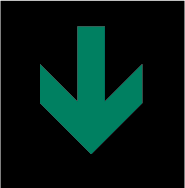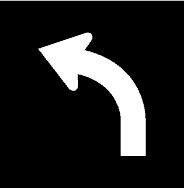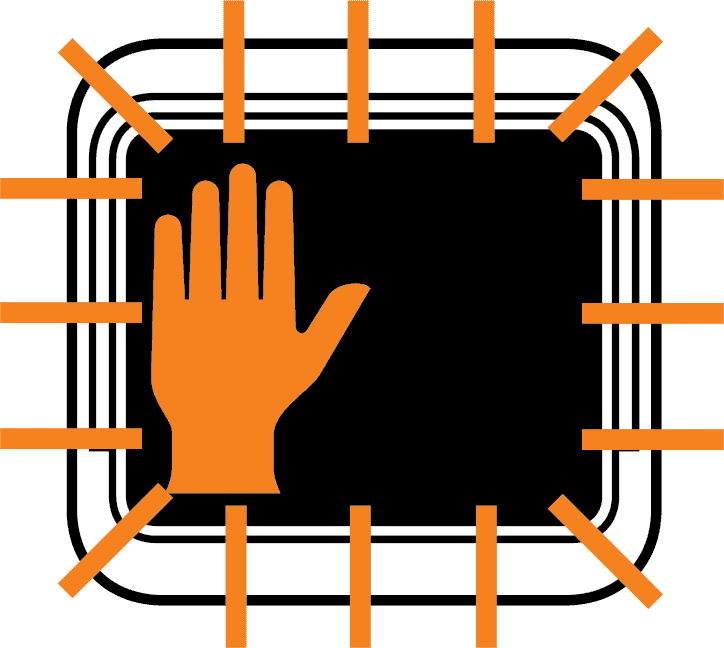You May Continue Carefully Through an Intersection With a Yellow Light if
Signals
Traffic signals are installed at intersections to control the movement of vehicles and pedestrians. Traffic signals are arranged in either vertical lines or horizontal lines. When they are arranged vertically, red is always on top and green on the bottom. When they are arranged horizontally, red is always on the left and green on the right.
Red, Yellow, and Green Traffic Lights and Arrows
 When there is a STEADY RED LIGHT, you must stop before crossing the marked stop line or crosswalk. If you do not see any lines, stop before entering the intersection. Wait for a green light before you start.
When there is a STEADY RED LIGHT, you must stop before crossing the marked stop line or crosswalk. If you do not see any lines, stop before entering the intersection. Wait for a green light before you start.
You may turn right while the light is red, unless a NO TURN ON RED sign is posted at the intersection. You must first stop, check for and yield to pedestrians and other traffic.
You may also turn left after you stop at a red light, if you are in the left lane and are turning left from a one-way street onto another one-way street, unless a sign tells you not to turn. You must first stop and yield to pedestrians and other traffic.
 A STEADY YELLOW LIGHT tells you a steady red light will soon appear. If you are driving toward an intersection and a yellow light appears, slow down and prepare to stop. If you are within the intersection or cannot stop safely before entering the intersection, continue through carefully.
A STEADY YELLOW LIGHT tells you a steady red light will soon appear. If you are driving toward an intersection and a yellow light appears, slow down and prepare to stop. If you are within the intersection or cannot stop safely before entering the intersection, continue through carefully.
 A STEADY GREEN LIGHT means you may drive through the intersection, if the road is clear. You may also turn right or left unless a sign tells you not to; however, when turning, you must yield to other vehicles and pedestrians within the intersection.
A STEADY GREEN LIGHT means you may drive through the intersection, if the road is clear. You may also turn right or left unless a sign tells you not to; however, when turning, you must yield to other vehicles and pedestrians within the intersection.
 A STEADY RED ARROW means you must stop and may not turn in the direction the arrow points. Wait for a Green Arrow or a Flashing Yellow Arrow before you start. The same turns-on-red that are allowed for a steady red signal are allowed for a steady red arrow.
A STEADY RED ARROW means you must stop and may not turn in the direction the arrow points. Wait for a Green Arrow or a Flashing Yellow Arrow before you start. The same turns-on-red that are allowed for a steady red signal are allowed for a steady red arrow.
 A STEADY YELLOW ARROW means the movement permitted by the green arrow or the flashing yellow arrow is about to end and the signal will soon turn red. You should slow down and prepare to stop completely before entering the intersection. If you are within the intersection or cannot stop safely before entering the intersection, you may complete the turn begun on the preceding arrow with caution.
A STEADY YELLOW ARROW means the movement permitted by the green arrow or the flashing yellow arrow is about to end and the signal will soon turn red. You should slow down and prepare to stop completely before entering the intersection. If you are within the intersection or cannot stop safely before entering the intersection, you may complete the turn begun on the preceding arrow with caution.
 A STEADY GREEN ARROW means you may turn the way the arrow points. When you turn during the green arrow phase, your turn is "protected" because oncoming traffic is stopped by a red light. If the green arrow turns into a green light, you may still turn in that direction, but first yield to pedestrians and oncoming traffic.
A STEADY GREEN ARROW means you may turn the way the arrow points. When you turn during the green arrow phase, your turn is "protected" because oncoming traffic is stopped by a red light. If the green arrow turns into a green light, you may still turn in that direction, but first yield to pedestrians and oncoming traffic.
Flashing Signals
 A flashing red light has the same meaning as a STOP sign. You must come to a complete stop. Then, look both ways, and proceed only after the intersection is clear.
A flashing red light has the same meaning as a STOP sign. You must come to a complete stop. Then, look both ways, and proceed only after the intersection is clear.
 A flashing yellow light means CAUTION. Slow down, look and proceed with care.
A flashing yellow light means CAUTION. Slow down, look and proceed with care.
 A FLASHING YELLOW ARROW means you may turn in the direction of the arrow with caution, however, you must first yield to oncoming traffic and pedestrians. When you turn during the flashing yellow arrow phase, your turn is NOT protected; oncoming traffic will have a green light.
A FLASHING YELLOW ARROW means you may turn in the direction of the arrow with caution, however, you must first yield to oncoming traffic and pedestrians. When you turn during the flashing yellow arrow phase, your turn is NOT protected; oncoming traffic will have a green light.
Non-Functioning Traffic Lights
A non-functioning traffic signal should be treated as though it were a four-way STOP sign.
Ramp-Metering Signals
Some highway entrance ramps have traffic signals at the end of the ramp that alternate between steady green and steady red. Ramp-metering signals are used to control the flow of traffic onto very congested highways and usually operate during peak rush hours. You must wait for the green signal before you enter the highway. On single-lane ramps, only one car may enter the highway each time the light turns green. For multi-lane on-ramps, there will be a ramp meter for each lane. The green light does not protect your entrance onto the highway — you must still look for a safe gap in traffic to enter the highway.
Lane Use Control Signals
Special signals may also be placed directly over lanes to control traffic. These are commonly used at toll booths, on bridges, tunnels, and on multi-lane roads in cities where the direction of travel for particular lane changes to ease the flow of traffic into or out of the city during peak rush hour. The following signals show how specific lanes of a street or highway should be used:
 A steady downward green arrow over a traffic lane means you may use the lane.
A steady downward green arrow over a traffic lane means you may use the lane.
 A steady yellow "X" over a traffic lane means you must change lanes because the direction of travel for that lane is about to be reversed. Get ready to leave the lane safely.
A steady yellow "X" over a traffic lane means you must change lanes because the direction of travel for that lane is about to be reversed. Get ready to leave the lane safely.
 A steady red "X" over a lane means you are not allowed to use the traffic lane.
A steady red "X" over a lane means you are not allowed to use the traffic lane.
 A white steady, one-way left-turn arrow over a lane means you may only turn left, if you are in that lane.
A white steady, one-way left-turn arrow over a lane means you may only turn left, if you are in that lane.
 A white steady, two-way left-turn arrow over a lane means you may only turn left, if you are in that lane, but the lane is shared by left-turning drivers approaching from the opposite direction.
A white steady, two-way left-turn arrow over a lane means you may only turn left, if you are in that lane, but the lane is shared by left-turning drivers approaching from the opposite direction.
Pedestrian Signals
Pedestrians must obey traffic and pedestrian signals. The pedestrian signals you must obey are the WALK and DON'T WALK lights or the lighted picture of a walking person (meaning walk) and an upraised hand (meaning don't walk). If there are no pedestrian signals at the intersection, pedestrians must obey the red, yellow, and green traffic lights.
Sometimes pedestrians are not aware of their responsibilities at traffic and pedestrian signals. Be alert for pedestrians, who may not obey the signal. Always yield to pedestrians.

 When a steady WALK or walking person comes on, start crossing, but be alert for turning vehicles that may not lawfully yield the right of way.
When a steady WALK or walking person comes on, start crossing, but be alert for turning vehicles that may not lawfully yield the right of way.

 When the flashing DON'T WALK or flashing upraised hand begins: a. Finish crossing, if you are in the street, b. Do not start to cross, if you have not left the curb.
When the flashing DON'T WALK or flashing upraised hand begins: a. Finish crossing, if you are in the street, b. Do not start to cross, if you have not left the curb.

 When the steady DON'T WALK message or steady upraised hand is displayed, do not cross.
When the steady DON'T WALK message or steady upraised hand is displayed, do not cross.
Blind Pedestrians
When driving near a blind pedestrian who is carrying a white cane or walking with a guide dog, you must slow down, always yield the right-of-way, and then proceed with caution. Be prepared to stop your vehicle in order to prevent injury or danger to the pedestrian.
School Zone Signals
 School zone signals are flashing yellow signals placed on the school zone speed limit signs. You must travel no faster than 15 mph when the yellow signals are flashing or during the time periods indicated on the sign. Exceeding the speed limit in a school zone will result in three points on your driving record, and you will also be fined.
School zone signals are flashing yellow signals placed on the school zone speed limit signs. You must travel no faster than 15 mph when the yellow signals are flashing or during the time periods indicated on the sign. Exceeding the speed limit in a school zone will result in three points on your driving record, and you will also be fined.
Railroad Crossing Signals
 Drivers are alerted when approaching a railroad crossing by the railroad crossing sign. Railroad crossings should be approached with caution at all times. You should always look both ways and listen for any approaching trains or signals before proceeding across the railroad tracks.
Drivers are alerted when approaching a railroad crossing by the railroad crossing sign. Railroad crossings should be approached with caution at all times. You should always look both ways and listen for any approaching trains or signals before proceeding across the railroad tracks.
You are required to stop at all railroad crossings when there is a signal of an approaching train. These signals include flashing red lights, a lowered crossing gate, a flagger signaling, or a train's audible signal of warning. Do not move forward or attempt to go around any gate or ignore any signal of an approaching train. If there are no signals at the railroad crossing, you should slow down and prepare to stop if you see or hear a train approaching.
Proceed with caution only after all signals are completed and then only when there is evidence no trains are approaching the crossing.
You should stop if a train is approaching and has sounded its audible signal or is plainly visible and in hazardous proximity to the crossing.
Do not stop your vehicle on a railroad track, regardless of whether a train appears to be coming. If traffic is backed up because of a traffic signal, stop sign, or for any other reason, make sure you stop your vehicle in a location where it will be entirely clear of any railroad tracks.
Refer to Chapter 3 for more information about how to safely cross a highway-railroad intersection.
Source: https://www.dmv.pa.gov/Driver-Services/Driver-Licensing/Driver-Manual/Chapter-2/Pages/Signals.aspx
0 Response to "You May Continue Carefully Through an Intersection With a Yellow Light if"
Post a Comment